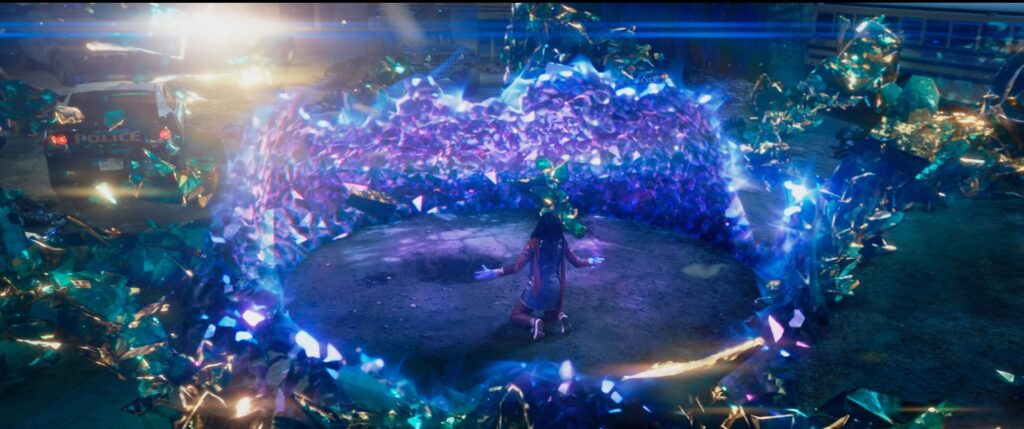VFX artists help transform Ms. Marvel’s comic-book powers into a new realm.
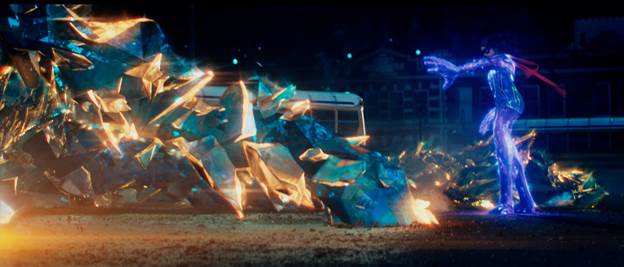
When Spider-Man dons his spidey costume, we know what to expect as he uses his web slinger and his incredible agility in battle. We are familiar with Doctor Strange’s mystical and magical knowledge, and the VFX that accompany his powerful spells. We delight in the resulting effect as Thor wields his hammer. When the Hulk flies into a rage, the result is excitingly familiar. And when Ms. Marvel invokes her superpowers… uh…. If you have not seen the streaming series Ms. Marvel on Disney+, you might not know what this latest character in the Marvel Cinematic Universe (MCU) can do. There’s a small chance that you saw her as a 2D cartoon in a Marvel comic book at some time or another. But, adapting the look to a live-action, VFX-filled production takes a certain degree of superpower by the effects artists.
As if giving superheroes their superpowers on screen isn’t difficult enough, in the case of Ms. Marvel, there were additional hurdles. Artists at Digital Domain and the other VFX facilities that worked on the production had to do so without using a former film or series as a guide. In fact, Ms. Marvel and her powers had to be reinvented for a whole new audience and for a whole new medium. After all, they were setting the stage for the character’s performance in future productions, as well. That “future” is right around the corner, as the character will appear in the 2023 film The Marvels.
“From the start, we knew that Ms. Marvel’s abilities were going to change for her live-action debut, but everyone involved still wanted to honor the comics,” says Digital Domain’s Aladino Debert, VFX supervisor on the series Ms. Marvel. “We went through several iterations with the production to find a balance that will impress people watching on TV, and still look great when the character makes the jump to the big screen.”
However, as Debert notes, visual effects for streaming content are now as sophisticated as any effects seen on the big screen. So for the artists, it was a matter of determining what was the best work they could create for the screen—any screen, whether for TV/phones or cinema. The tools and the creative efforts are the same, he adds.
Since Ms. Marvel’s comic-book debut, four different characters bore the moniker of Ms. Marvel: Carol Danvers (who later becomes Captain Marvel), Sharon Ventura, Karla Soften (as a Dark Avenger iteration), and Kamala Khan (in 2013). The title character in the series (Iman Vellani) is based on Khan, a 16-year-old Pakistani American from New Jersey who assumes the mantel of Ms. Marvel from her idol, Carol Danvers.
In the comics, Ms. Marvel exhibits the power of elongation (she can extend her limbs, torso, or neck), alters her size by shrinking and growing, and body morphs into other people or objects. She also has the power to heal. Not exactly practical concepts for live action. Instead, showrunners reinterpreted her abilities, now associated with the Noor “light dimension,” through which the live-action Ms. Marvel can generate and manipulate Noor energy, or hard light.
“The comic-book powers of Ms. Marvel are quite different to what was developed for the show. In the comics, she can stretch and contort her body like the Fantastic Four’s Reed Richards, while also making herself huge or tiny, like Ant-Man. In the series, however, the creatives wanted to come up with something new, more in tune with the MCU’s look. So, the idea of this Noor energy, which both Kamala and Kamran (her friend) can channel and manipulate to different degrees, was written into the scripts,” Debert explains. “But being something ‘fantastical’ meant that there was nothing to go by as far as references were concerned. Developing the perfect look required a long process involving concept frames and tests, and involving multiple studios.”
“Her powers not only were brand new from a stylistic point of view, but also had no counterpart in real life. At the same time, since no one had ever seen her powers before on the screen, it was a matter of finding a good balance among all the interested parties,” Debert adds. “Every time you have to create something that has no real-life counterpart, it’s both challenging and exciting. In the end, we came up with a look for both Kamala and Kamran that was similar in nature, and yet different in overall look.”
That design suggests an otherworldly source while still honoring the comic history. The result was a crystalline manifestation that radiated energy, highlighted by an internal luminance—a blueish-purple base.
To create those effects, the artists began with some concept frames “to flush out the basics,” says Debert, as they do with most effects involving physical aspects (water, fire, smoke, and in this case, Noor) and magical things such as Doctor Strange’s and Scarlet Witch’s powers. Then tests are done in Side Effects’ Houdini until they get the look and behavior they want. Since these powers affect the surrounding space—they are physically-based, even if magical in nature—things such as ground destruction, dust, debris, and so forth had to be generated as well.
As Ms. Marvel reaches the full potential of her powers, the artists refined the look to suggest that her powers had become an extension of her. She also becomes capable of shaping the hard light to enlarge herself and create the sense of stretching and expanding her limbs and hands—a nod to her comic-book roots.
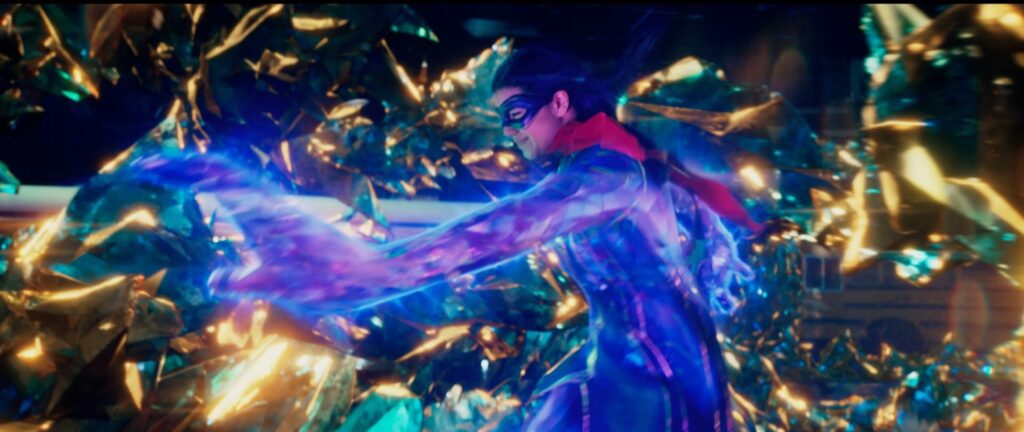
In parallel to the luminance, “we used [Autodesk’s] Maya to block out timing of certain things like Kamran’s shockwaves and the Noor tendrils he emits when he ‘unbounds’ in the season finale,” says Debert. “In the case of Kamala, she also has Noor body armor, shields, and additional manifestations of her powers. For those, we either tracked her body performances (or used full-CG digi-doubles) and created her ‘embiggened’ self in Maya, or simply animated basic shapes that were then simulated and rendered in Houdini.”
Creating the Noor energy powers, says Debert, were among the most challenging aspects for the studio on this production. Making something that does not exist in nature can always be tough, he adds, so the look of those powers was open to a lot of interpretation and creative subjectivity. Additionally, since the design deviated from the comics, whereas the character had powers that are similar to Reed Richards (Mister Fantastic) of Fantastic Four, the artists had to do a lot of experimenting until they found a style and behavior that everyone was happy with.
Environments, digi-doubles, and more
As Debert notes, Digital Domain’s work on the series extended beyond the VFX depicting Ms. Marvel’s powers to include set extensions for locations in New York City, New Jersey, and India, as well as digi-doubles for various sequences and one-off effects.
One of the more difficult scenes involved a multi-shot sequence. Near the end of “seeing Red” (episode 4), Kamala is transported back in time, and climbs atop a structure for perspective, only to discover that she is in a crowded rail station surrounded by trains and refugees on the eve of the partition of India (into India and Pakistan). For this sequence, the studio began with actual footage shot at a present-day train station with a small group of extras. The artists then set the scene in 1947 by extending it with buildings, train cars and steam locomotives, and more. Using Houdini’s crowd tool, they later filled the set with digitally produced and replicated people made from scans of actors dressed in period clothing. The final scene was rendered in SideFX’s Mantra.
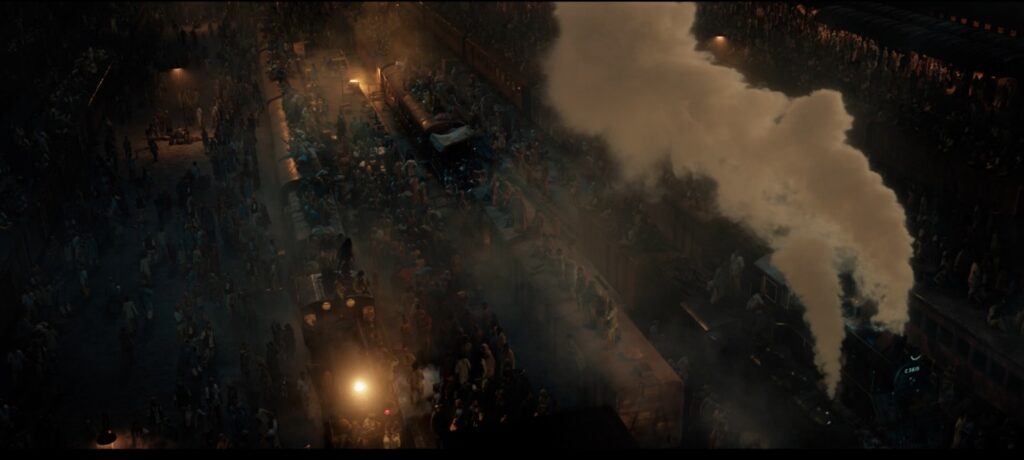
A large part of Digital Domain’s work was centered on the last episode, “No Normal,” which required VFX that included shape-changing characters, digi-doubles, explosions, and more. In the episode, Ms. Marvel and her friends are being chased by armed agents of the Department of Damage Control. They hole up at the local high school, where they set various traps for their aggressors. One of those hazards is a VFX version of the so-called real-life elephant toothpaste chemistry experiment that results in a foamy substance. In real life, it is a large amount, hence its name. In Ms. Marvel, it is huge amount that is generated not by a chemical reaction, but by CG artists, who then animated the computer-generated substance as it fills the lab and flows through the hallways and down the stairs.
The showdown eventually pits Kamran against the agents, as Ms. Marvel attempts to defuse the situation while protecting bystanders. As Kamran loses control, he unleashes a pulsating shockwave that damages nearby objects and entangles Ms. Marvel as she tries to protect the crowd. For visual continuity and safety, partial digi-doubles were used in the scene, created from scans of the actors.
Digi-doubles were also used in other scenes, including the iconic shot at the end of the series in which Ms. Marvel is perched atop a lamppost and looking out at the city. In this Chaos V-Ray-rendered scene, a prop lamppost was surrounded by greenscreen; later, CG water, a dock, and cars were added. The buildings depicted along the Jersey City shoreline were created using Lidar scans of locales in Atlanta, while a plate of NYC rounded out the scene.
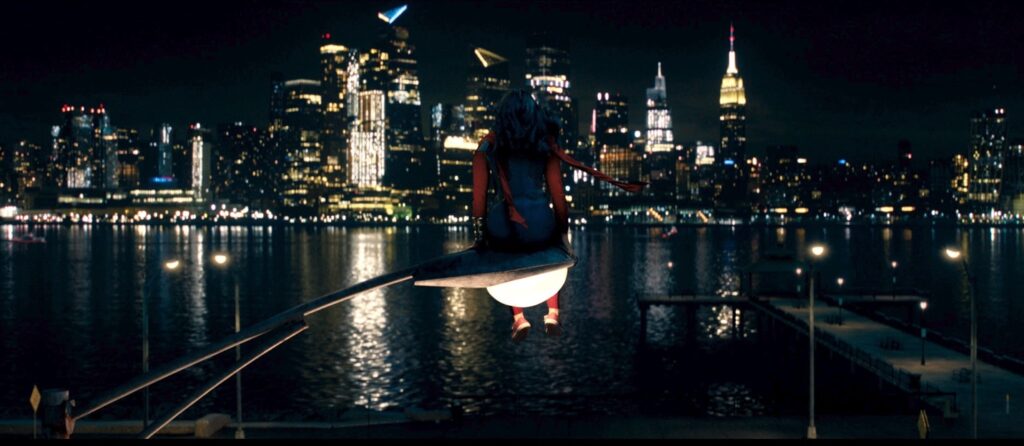
In the broadest sense, this production gave Digital Domain the chance to work on another groundbreaking project, with a new hero being introduced to MCU fans who happens to be a teenage Pakistani American Muslim girl, no less. “More specifically, even though the grand finale Noor extravaganza was certainly fun, I enjoyed working on shots that tended to be ‘invisible,’ like her digi-double running through the streets of New Jersey (which was actually Atlanta), the elephant toothpaste chemistry experiment explosion in the school, and the iconic shots of Kamala sitting on a light pole facing Manhattan, which are [all] 95% digital,” Debert says.
Sharing the VFX work with Digital Domain on the six-episode series was Method Studios, The Third Floor (visualization), Trixter, Folks VFX, Rise FX, MPC, Framestore, and others. While there is always speculation following a well-received MCU series, there is no official word as to whether there will be a season 2 (so far only Loki has been greenlighted for a Disney+ MCU second season). Nonetheless, Ms. Marvel will share the big screen with Captain Marvel, Nick Fury, Spectrum, and others in the upcoming feature film The Marvels, directed by Nia DaCosta and expected to be released July 2023.
